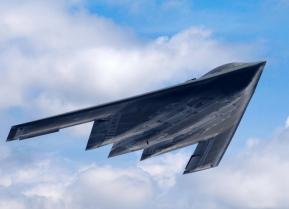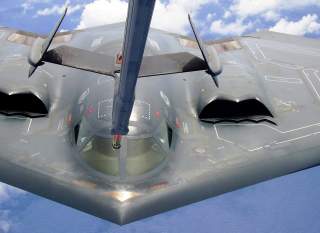Air Force Pilot on the B-2 Stealth Bomber: “It is really an awesome bombing platform."
And this is why.
“The Polyimide material presently used for HTE degrades quickly in this operational environment; as the incessant exposure to heat and engine exhaust exceeds its capabilities, the material cracks and the resin disintegrates,” an Air Force statement said last year.
Therefore, recognizing the need for more resilient materials, the Air Force Research Lab engineered a new application based on AFR PE 4, service information states. AFR-PE-4 is a high-temperature thermosetting polyimide resin with service capability up to 343-degrees Celsius, according to information from Maverick Molding. Maverick, a high-temperature polymer firm, says they commercialized AFR-PE-4 after it was first developed by the Air Force.
Engineers working on stealth technology designs often try to reduce the “heat signature” or infrared/thermal sensor detectability of the aircraft. The more heat a bomber gives off in flight, the more enemy sensors and radar are likely to detect it. Therefore, it seems evident that a material less prone to degradation or disintegration at high- temperatures might likely lessen the heat signature emitted from decay or erosion taking place on the aircraft.
After extensive testing and demonstrations going back several years, the Air Force and B-2 prime contractor Northrop Grumman are now moving forward with plans to produce the new composite HTE components; Northrop recently awarded a five-year, $90 million deal to Orbital ATK to manufacture 17 HTE composite parts, a Northrop announcement said. Production will take place at Orbital ATK’s Aerospace Structures Division facility in Dayton, Ohio, later this year.
The replacement showcases the coordinated efforts of personnel from AFRL, Hill Air Force Base (Utah) and the University of Dayton Research Institute (Dayton, Ohio), Air Force officials said.
Northrop Grumman’s major subcontractors on the program are BAE (receivers), Ball Aerospace and L-3 Randtron (antennas), and Lockheed Martin (display processors).
The Air Force currently operates 20 B-2 bombers, with the majority of them based at Whiteman AFB in Missouri. The B-2 can reach altitudes of 50,000 feet and carry 40,000 pounds of payload, including both conventional and nuclear weapons.
Osborn previously served at the Pentagon as a Highly Qualified Expert with the Office of the Assistant Secretary of the Army - Acquisition, Logistics& Technology. Osborn has also worked as an anchor and an-air military specialist at national TV networks. Osborn has a Masters Degree in Comparative Literature from Columbia University.
This first appeared in Warrior Maven here.


